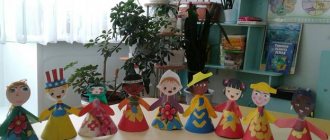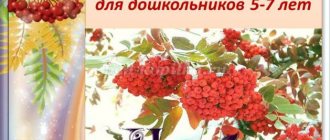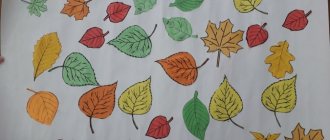Thematic planning “Theater Week” in the preparatory school group
Thematic planning “Theater Week” in the preparatory school group
Goal: Development of children's abilities through theatrical art.
Objectives: Create conditions for the development of creative activity of children participating in theatrical activities. To improve children's artistic skills in terms of experiencing and embodying the image, as well as their performing skills. Teach children the elements of artistic and figurative means of expression (intonation, facial expressions, pantomime). Activate children's vocabulary, improve the sound culture of speech, intonation structure, and dialogic speech. To develop experience in social behavior skills and create conditions for the development of children’s creative activity. Introduce children to various types of theater (puppet, musical, children's, animal theater, etc.). To develop children's interest in theatrical play activities
Classes are designed for children of senior preschool age (6-7 years old).
Working with parents:
• Visual propaganda about holding a theater week in a preschool educational institution.
• Conversations with parents on the topic of the week.
• Visual information “The importance of theatrical activities in the life of a preschooler”
| date | Time periods of the day | Joint activity of teacher and child | Independent activity | Cooperation with family (social partners) | |
| Organization of children's activities | Forms of organization | Organization development environment | |||
| Monday Monday | Morning | 1.Cognitive | Conversation with children “We came to the theater” Introducing the concept of theater: (showing slides, paintings, photographs). Types of theaters (musical, puppet, dramatic, animal theater, etc.). Purpose: to give children an idea of the theater; expand knowledge of theater as an art form; introduce types of theaters; cultivate an emotionally positive attitude towards the theater. | Types of theaters (musical, puppet, dramatic, animal theater, etc.). Purpose: to give children an idea of the theater; expand knowledge of theater as an art form; introduce types of theaters; cultivate an emotionally positive attitude towards the theater. Plot-role-playing game “We came to the theater.” | Invite parents to talk with children about theatrical professions (artist, make-up artist, hairdresser, musician, decorator, costume designer, actor). Goal: to form children’s ideas about theatrical professions; to intensify interest in theatrical art; Expand words knowledge. |
| OOD | Social - communicative 2. Artistic and aesthetic | “We played and danced” - an imitation of accompanying nursery rhymes on children's musical instruments. Improvisation on a theme with sounding movements Song improvisation | |||
| Walk | Cognitive and research Game motor | Walk No. 1 See the card index for September. Outdoor game “We are funny guys.” | |||
| Evening Communicative; Constructive; Motor; Gaming; Perception of fiction. | Plot-role-playing game “We came to the theater.” Purpose: to introduce the rules of behavior in the theater; arouse interest and desire to play (play the role of “cashier”, “ticketer”, “spectator”); cultivate friendly relationships. 2. Conversation about the rules of conduct in the Spectator Culture theater. Goal: To give children an idea of the rules of conduct in public places; to form a personal attitude towards non-compliance and violation of rules. | ||||
| Independent activities of children | Gaming Communication | Free games for children Learning finger gymnastics | Add a card index of dynamic pauses and breathing exercises on a lexical topic. |
Contents of educational activities
| date | Time periods of the day | Joint activity of an adult and a child | Independent activity | Cooperation with family (social partners) | |
| Organization of children's activities | Forms of organization | Organization development environment | |||
| Tuesday | Morning | Social - communicative | “We are playing theater” - mimic gymnastics | Add a selection of illustrations and coloring pages. Add to the group a card index of designs for constructing from counting sticks. | Invite parents to play the game “Guess Who I Am?” with their children. |
| OOD | 1.Communicative | “We are future artists” - exercises for the development of expressive plasticity of movements, for the development of expressive facial expressions. “I’ll change myself, friends, guess who I am?” - dressing up in costumes, imitation sketches. Introduction to the fairy tale “The Bag of Apples” | |||
| Walk | Cognitive and research Game motor | Walk No. 2 See card index for September. Outdoor game "Falling Leaves". | |||
| Evening Communicative Constructive Motor Gaming | Plot-role-playing game “Let's play at the theater.” Finger theater “Ryaba Hen” (at the teacher’s choice). Goal: to develop children’s ability to use finger theater in free activities; distribute characters; convey the characteristic features of the heroes of the fairy tale. | ||||
| Independent activities of children | Gaming Communication | Free games for children: Making riddles. Goal: to teach children, when solving a riddle, to motivate their answer (this allows you to judge how children can compare a description with a real object or phenomenon), to develop auditory attention and logical thinking. | Add to the group a file cabinet of design schemes from building materials. |
Contents of educational activities
| date | Time periods of the day | Joint activity of an adult and a child | Independent activity | Cooperation with family (social partners) | |
| Organization of children's activities | Forms of organization | Organization development environment | |||
| Wednesday | Morning | Social - communicative | “It’s very difficult to live in the world without a girlfriend or boyfriend!” Reading a poem - “Say a kind word about a friend”, Performing the song “If you went on a journey with a friend”, music. V. Shainsky 2. Fairy tale “The Bag of Apples” - to develop the ability to follow the development of actions, to involve in the telling of a fairy tale, to convey the character and emotional state of the selected personnel, to arouse interest in what is happening, to intonationally and expressively convey the character of the selected personnel | Add a selection of books and illustrations Dramatization of a fairy tale by teachers | Invite parents to watch the cartoon with their child - the fairy tale Little Red Riding Hood, The Tsokotukha Fly, Fedorino's Grief, Kolobok, Teremok, Turnip, Bag of Apples discuss what you saw |
| OOD | 1.Cognitive 2.Motor | Teacher’s story “The history of the creation of the puppet theater” Physical development indoors (mastery of basic motor skills, performing movements according to a pattern). | |||
| Walk | Cognitive and research Game motor | Walk No. 3 See card index for September. Outdoor game "Sparrows and a car." Goal: to teach children to run in different directions without bumping into each other, to start moving and change it at the teacher’s signal, to find their place. | |||
| Evening | Communicative Constructive Motor Game Perception of fiction | Children's games with sounding instruments. Goal: to give children an idea of the musical design of performances. An evening of riddles based on the works “Little Red Riding Hood”, “Tsokotukha the Fly”, “Fedorino’s Grief”, “Kolobok”, “Teremok”, “Turnip”. S/r game “A trip to the puppet theater”. Purpose: To acquaint children with the structure of the theater building, to draw attention to the originality of the architecture and the beautiful facade. Enrich children's vocabulary. Free games. | |||
| Independent activities of children | Artistic and aesthetic Communication | Individual work on speech development, game “Say the other way around.” Dima and Polina. Goal: Replenishment of active vocabulary. Making paper crafts according to patterns. | Add to the group diagrams for making paper crafts on a lexical topic. |
Contents of educational activities
| Thursday Friday | Time periods of the day | Joint activity of an adult and a child | Independent activity | Cooperation with family (social partners) |
| Organization of children's activities | Forms of organization | Organization development environment | ||
| OOD | 1. Artistically aesthetic 2. Artistic and aesthetic | Theatrical game “Circus of Animals” - consolidating the elements of acting, memory, and imagination in the game. Conversation with children “The World of Circus”, “The famous artist Yuri Nikulin”. I'll draw my favorite animal Discussion of roles in the fairy tale “The Bag of Apples”, distribution of roles Music according to the music director's plan. | Add a selection of illustrations depicting animals exhibition of drawings | Offer parents and their child creative games: “Good - bad” - the rules of behavior in the theater, the players portray using facial expressions and pantomime. Game “Animals in the Zoo”, game “Animal Voices” |
| Walk | Cognitive and research Game motor | Walk No. 4 See card index for September. Improvisation game “Inflate, my balloon.” | ||
| Evening Communicative Motor Game Perception of fiction | Psycho-gymnastics. "Different faces." Goal: Encourage children to experiment with their appearance (facial expressions, gestures). Develop children's ability to switch from one image to another. Showing the fairy tale “Zayushkina’s Hut” (at the teacher’s choice). After the show, invite the children to try to play with the fairy tale characters on their own using toys. Goal: introducing children to theatrical art. | |||
| Independent activities of children | Artistic and aesthetic Communication | Independent activity of children in the theater corner. Looking at bi-ba-bo dolls with children. A conversation about how to properly use dolls, which is a tool for driving bi-ba-bo dolls. Goal: Improve puppeteering techniques, consolidate knowledge about the rules for manipulating theatrical puppets of different systems. | Add puppet theater to the group. |
Contents of educational activities
| date | Time periods of the day | Joint activity of an adult and a child | Independent activity | Cooperation with family (social partners) | |
| Organization of children's activities | Forms of organization | Organization development environment | |||
| Friday | Morning | Social - communicative | Introduction to musical theaters. Purpose: To give an idea of the various genres of musical theater, such as “opera”, “ballet”, “musical fairy tale”. Rehearsal of the play “Sack of Apples” | Add to group s.-r. games. Audio recording of opera melody, musical fairy tales | Performance of the play “Sack of Apples” for parents and children |
| OOD | 1.Cognitive 2.Motor | Drawing. Making a poster for the play “Sack of Apples”, group work Physical education on the street. | |||
| Walk | Cognitive and research Game motor | Walk No. 5 See card index for September. Outdoor game “Along a narrow path.” | |||
| Evening | Communicative Motor Game Perception of fiction. | Musical folk and round dance games according to the age of children. Goal: Encourage children to actively participate in games. | |||
| Independent activities of children | Artistic and aesthetic Communication | Rhythmoplasty. Sketches for movement: “The Fox is Coming”, “Dance of the Animals”. Goal: To develop children's ability to use gestures. Voice-over of a fairy tale chosen by children using noise instruments. Encourage children to creatively interpret famous stories using noise instruments | Add noise instruments to the group |
Get text
Theater week for preschoolers in kindergarten
Theater week project “Theater Kaleidoscope”
Implemented the project: Vesnina O.V.
Semyonova I.S., teachers of the kindergarten “Ryabinushka” Relevance: The whole life of children is filled with play. Every child wants to play their role. Theater helps to teach a child to play, take on a role and act, while at the same time helping him gain life experience. Theater is one of the most accessible forms of art for children, helping to solve many pressing problems of modern pedagogy and psychology related to: • artistic education and upbringing of children; • formation of aesthetic taste; • moral education; • development of personal communicative qualities; • education of will, development of memory, imagination, initiative, fantasy and speech; • creating a positive emotional mood, relieving tension, resolving conflict situations through play. The subject of theatrical activities is not limited and can satisfy any interests and desires of the child. By participating in it, children get acquainted with the world around them in all its diversity - through images, colors, sounds, music. In the process of working on the expressiveness of the characters’ replicas of their own statements, the child’s vocabulary is activated and the sound culture of speech is improved. The role played, especially the dialogue with another character, confronts the little actor with the need to express himself clearly, distinctly, and intelligibly. With the help of theatrical activities in kindergarten, the child’s creative potential is revealed. Children learn to notice interesting ideas in the world around them, implement them, and create their own artistic image of a character. Therefore, it is theatrical activities that make it possible to solve many pedagogical problems related to the formation of the expressiveness of a child’s speech, intellectual and artistic aesthetic education. It is an inexhaustible source of development of feelings, experiences and emotional discoveries, a way of becoming familiar with spiritual wealth. As a result, the child gets to know the world with his mind and heart, expressing his attitude towards good and evil, and learns the joy associated with overcoming communication difficulties and self-doubt. The purpose of the theatrical week: Improving the development of creative abilities of preschool children through organizing the interaction of children and adults in joint theatrical activities. Objectives of the theatrical week: 1. To form an understanding of the theater among preschool children through excursions and theatrical performances. 2. Develop the artistic abilities of preschoolers through theatrical art. 3. Stimulate an emotionally positive perception of the theater in students, creating a zone of shared experiences. Expected results: During the implementation of the project, the following results will be obtained: 1. Pupils of different age groups will become acquainted with the history of the theater and various types of theater: finger theater, tabletop, shadow, puppet theater, drama theater, operetta.
2. Preschoolers will become familiar with the culture of behavior in the theater. 3. The level of development of acting abilities in preschool educational institutions will increase: • act freely and relaxed when performing in front of adults and peers; • improvise works using facial expressions, pantomime, expressive movements and intonation (while conveying the characteristic features of various characters); • distinguish the mood, experiences, emotional state of characters and convey them in the process of playing roles; 4 Pupils will increase their level of emotional responsiveness to works of art (music, theater, dance). Project implementation stages:
The implementation of the project includes three stages: preparatory, main and final, which are carried out in a certain sequence.
Stage I - preparatory stage
During the preparatory stage, a number of organizational measures are carried out necessary for the implementation of the main stage: studying methodological literature on the topic “Features of organizing theatrical activities in preschool educational institutions”;
obtaining and analyzing information about the interests of children and parents, selecting forms and methods of working with children necessary for carrying out activities during the theater week; creation of a subject-development environment necessary for the implementation of theatrical activities in all age groups; carrying out preparatory work for carrying out main activities. Stage II – main stage
Carrying out theater week events.
Stage III - final
The final stage is aimed at reflecting on the events held within the framework of the theatrical week. There will also be an exchange of views between teachers and parents of preschool educational institutions on the effectiveness of these events.
PHOTO REPORT ON THE THEMATIC WEEK “THEATRAL KALEIDOSCOPE”
Parents’ participation in staging the fairy tale “Turnip” in a new way
Theatrical performance based on the fairy tale “How the Chicken Got Big”
Theatrical performance based on the fairy tales “Who Said MEOW” and “Cabbage Leaf”
Participation of parents in the production of the fairy tale “The Wolf and the Seven Little Goats”
We recommend watching:
Theatrical activities in kindergarten Theater in the second junior group Do-it-yourself hat. Master class with step-by-step photos Script of a theatrical performance for children with disabilities (CP)
Similar articles:
Dramatization of Chukovsky's fairy tale The Fly Tsokotukha for children 5-7 years old
Dramatization of a fairy tale in the senior group “About the Little Mouse”
Theater performance in the senior group. Fox-sister and gray wolf
Theater quiz for the senior group
Game performance in kindergarten. Middle - senior group
Long-term plan for working with middle-aged children
Objectives of theatrical entertainment activities for middle-aged children:
Continue to develop and maintain children’s interest in theatrical activities by acquiring more complex gaming skills (monitor the development and interaction of characters)
Develop performing skills (role embodiment, ability to act in an imaginary plan)
Perform simple performances based on familiar literary works, using expressive means (intonation, facial expressions) to embody the image.
Introduce various types of theater (stand theater, mask theater, plane picture theater, finger theatre, picture theater on the hand, riding puppet theater (puppets on “spoons”) - help children accumulate ideas about various types of puppet theater, scenery, teach techniques puppeteering of various types of dolls.
Expected results:
By accumulating emotional and sensory experience and interacting, children will begin to take initiative and offer new roles or actions that enrich the plot.
In independent theatrical games, they will begin to arrange a place for the game, to embody the role (movements, intonation, facial expressions)
Master the techniques of puppeteering various types of puppets.
Children treat each other kindly; become more confident.
Perspective lesson plan “Theater of Everything”, middle group
| № | Name | Month |
| 1 | 1. “We are playing theater” - articulation gymnastics 2. “We are future artists” - exercises for the development of expressive plasticity of movements, for the development of expressive facial expressions. 3. “I’ll change myself, friends, guess who I am?” - dressing up in costumes, imitation sketches 4. Sign language - conversation with children | September |
| 2 | 1. Theatrical sketch “About Mushrooms” - reading and conversation based on the content, searching for expressive intonations, facial expressions, gestures to convey the image. 2. The fairy tale “Colors of Autumn” - work on individual episodes, expressiveness of speech 3. Display of a fairy tale with scenery details, musical accompaniment, and costume elements. Theatrical dictionary “Costumer”, “Make-up artist”. 4. The “Generous Autumn” holiday - enrich with vivid impressions, evoke a desire to take an active part in the holiday. | October |
| 3. | 1. “It’s very difficult to live in the world without a girlfriend or boyfriend!” Reading a poem - “Say a kind word about a friend”, Performing the song “If you went on a journey with a friend”, music. V. Shainsky 2. The fairy tale “Teremok in a new way” - to cultivate the ability to monitor the development of actions, to involve in the telling of a fairy tale, to convey the character and emotional state of the selected personnel. 3. The fairy tale “Teremok in a new way” - arouse interest in what is happening, intonationally and expressively convey the character of the selected personnel. 4. Showing fairy tales to children of other groups. | November |
| 4 | 1. Comic performances and pantomimes 2. Staging “On a visit to the Christmas tree” - creative tasks, distribution of roles 3. Theatrical game “Circus of Animals” - consolidating the elements of acting, memory, and imagination in the game. 4. “New Year’s holiday!” - create a joyful mood, evoke a desire to actively participate in the holiday. | December |
| 5 | 1. Creative games: “Good - bad” - rules of behavior in the theater, players portray using facial expressions and pantomime. Game “Animals in the Zoo”, game “Animal Voices” 2. "Christmas festivities" 3. Picture theater “We play and sing” 4. Introduction to the puppet theater | January |
| 6 | 1. Dramatization of familiar songs 2. Tabletop theater 3. “The Gray Wolf and Little Red Riding Hood”, based on the fairy tale by C. Perrault. Conversation on content. Getting into character. 4. “The Gray Wolf and Little Red Riding Hood” - convey the character and emotional state of the selected character intonationally and expressively. | February |
| 7 | 1. Showing the fairy tale “The Gray Wolf and Little Red Riding Hood” at the All Ladies’ Day, using musical costumes and attributes. musical arrangement. 2. Theatrical game “Pump” and inflatable toy: act with imaginary objects, interact with each other. 3. Finger theater “Fox, Hare and Rooster” - work on individual episodes, on the expressiveness of speech. 4. Showing the fairy tale “The Fox, the Hare and the Rooster” to children of younger groups. | March |
| 8 | 1. “We played and danced” - imitation of accompanying nursery rhymes on children's musical instruments. 2. Improvisation on a theme using sounding movements 3. Song improvisation 4. Flannelograph Theater | April |
| 9 | 1. Comic poems: play around, assign roles yourself 2. Sound therapy 3. Fabulous concert. Dramatizations of fairy tale fragments. “There are many fairy tales in the world - kind and funny, and we cannot live in the world without them.” | May |




